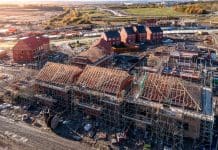Glenigan’s UK Construction Industry Forecast 2024-2026 shows a promising post-election boost for the sector, as the new Government reduces political uncertainty
Although the Glenigan Forecast predicts near-term challenges including slow economic growth and persistently high interest rates, a post-election boost to the sector has also been observed, as markets rally and efforts are made to cut through planning delays.
Policy decisions around construction projects will likely be made at a faster pace, boosting performance. This points to a strengthening economy expected to boost consumer spending and investor confidence in the back-end of 2024.
This signals recovery in the not-so-distant future, with a modest increase in project-starts predicted in the latter half of 2024 lifting starts by 3% this year. As the economy picks up further in 2025, Glenigan forecasts 7% growth, and 6% in 2026.
A sluggish start to 2024 for UK construction
Construction starts have remained slow during the first six months of 2024, as high interest rates and a weak economic outlook dented investor and consumer confidence.
The General Election has also affected the pipeline of public-sector construction projects. The purdah period has disrupted the progress of public-funded projects, while decisions will also be delayed post-election as the new Labour government reviews existing programmes such as the Lower Thames Crossing.
The Spending Review is predicted to boost public sector activity
However, an easing in borrowing costs and improved economic conditions – with the UK economy forecast to grow around 0.8% in 2024 – together with greater political certainty, should help to lift investor confidence from the second half of 2024 and into next year.
Despite a tough start, renewed growth in project-starts is forecast for H2 2024. The gradual easing of interest rates is also expected to feed through to lift housing market activity from the second half of this year.
Further, the Spending Review will set out the new government’s funding commitments and priorities and is expected to strengthen public sector construction activity during the second half of the forecast period.
Gradual growth will be the true reward of the post-election boost
Commenting on the Forecast, Glenigan’s economic director Allan Wilen says, “There are signs of growth, signalling a gradual recovery. For example, in the private housing sector, we anticipate starts will pick up in the latter half of this year, driven by improved affordability and brighter economic prospects.
“Similarly, we’re forecasting improved activity in consumer-related verticals such as retail and hotel & leisure, as a gradual easing in price inflation is set to provide a boost to households’ spending power. Elsewhere, structural changes are expected to create new opportunities in office refurb and fit-out, while logistics is poised for renewed investment fuelled by online retail growth.”
The impact of Labour’s majority is yet to be seen
However, he acknowledges the seismic results of the recent General Election will have a significant upfront impact on industry performance, particularly in the public sector, “No one could have predicted a landslide of such large proportions and, whilst the uncertainty during the pre-Election period hinted at a slower pace of recovery, we could easily see an acceleration as the Labour Government removes barriers to getting shovels in the ground from easing planning restrictions to embarking on major capital projects.
“It will be interesting to return to our predications in November, when the new administration has had time to make its mark, announce its autumn budget and publish its keenly anticipated Spending Review.”














